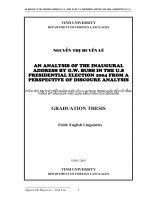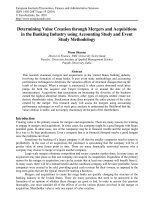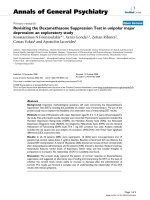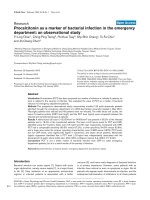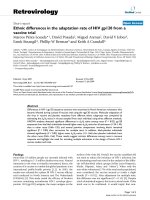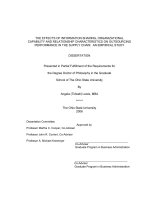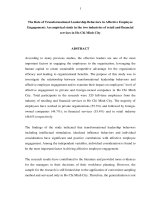Manufacturing location decisions in the pharmaceutical industry an exploratory study from a network perspective
Bạn đang xem bản rút gọn của tài liệu. Xem và tải ngay bản đầy đủ của tài liệu tại đây (1.87 MB, 195 trang )
MANUFACTURING LOCATION DECISIONS
IN THE PHARMACEUTICAL INDUSTRY:
AN EXPLORATORY STUDY FROM A NETWORK PERSPECTIVE
MATHIEU PELLERIN
A THESIS SUBMITTED FOR THE DEGREE OF MASTER OF ENGINEERING
DEPARTMENT OF INDUSTRIAL AND SYSTEMS ENGINEERING
NATIONAL UNIVERSITY OF SINGAPORE
2003
MANUFACTURING LOCATION DECISIONS
IN THE PHARMACEUTICAL INDUSTRY
MATHIEU PELLERIN
2003
Acknowledgement
This research would not have been possible without help and support from many people
and organizations. I wish particularly to express my greatest gratitude to the following:
•
My supervisors, Dr Yap Chee Meng and Dr Chai Kah Hin, for their invaluable
advice and support throughout the whole research project.
•
The managers of the pharmaceutical company, which was at the centre of my case
study, particularly for their good will and interest in this project.
•
The Industrial and Systems Engineering department for its financial support; its
staff and my lab-mates of the National University of Singapore, who welcomed
me.
•
Finally, my family, who let me go away for a hard year, and my friends, both in
France and in Singapore, for their patience, encouragement, understanding and
continuous support throughout my research.
I
MANUFACTURING LOCATION DECISIONS
IN THE PHARMACEUTICAL INDUSTRY
MATHIEU PELLERIN
2003
ACKNOWLEDGEMENT ------------------------------------------------------------------------- I
SUMMARY-----------------------------------------------------------------------------------------IV
LIST OF TABLES --------------------------------------------------------------------------------VI
LIST OF FIGURES ---------------------------------------------------------------------------- VIII
1. INTRODUCTION------------------------------------------------------------------------------1
1.1. RESEARCH BACKGROUND ---------------------------------------------------------------------1
1.2. RESEARCH PRESENTATION --------------------------------------------------------------------2
2. LITERATURE REVIEW---------------------------------------------------------------------6
2.1. INTRODUCTION ---------------------------------------------------------------------------------6
2.2. MANUFACTURING LOCATION DECISIONS ----------------------------------------------------6
2.3. INTERNATIONAL MANUFACTURING NETWORKS ------------------------------------------ 17
2.4. OUTSOURCING-------------------------------------------------------------------------------- 27
2.5. RESEARCH GAPS AND FORMULATION OF RESEARCH QUESTION -------------------------- 38
2.6. CONCLUSION --------------------------------------------------------------------------------- 40
3. RESEARCH METHODOLOGY---------------------------------------------------------- 42
3.1. INTRODUCTION ------------------------------------------------------------------------------- 42
3.2. RESEARCH APPROACH AND METHOD SELECTION ------------------------------------------ 42
3.3. DATA COLLECTION TECHNIQUES ----------------------------------------------------------- 46
3.4. ORGANIZATION OF THE DATA COLLECTION FOR THE CASE STUDIES --------------------- 46
3.5. DATA ANALYSIS PROCEDURE --------------------------------------------------------------- 48
3.6. VALIDATION OF THE MEANS OF DATA MEASURING --------------------------------------- 49
3.7. SUMMARY OF THE RESEARCH PROCESS ---------------------------------------------------- 50
3.8. RESEARCH SCOPE ---------------------------------------------------------------------------- 50
3.9. RESEARCH IMPLEMENTATION --------------------------------------------------------------- 51
3.10. CONCLUSION --------------------------------------------------------------------------------- 54
4. EXPLORATORY CASE-------------------------------------------------------------------- 55
4.1. INTRODUCTION ------------------------------------------------------------------------------- 55
4.2. UNFOCUSED FIELD STUDY ------------------------------------------------------------------- 55
4.3. PRELIMINARY CASE (CASE 1)--------------------------------------------------------------- 64
4.4. CONCLUSION --------------------------------------------------------------------------------- 66
5. PILOT CASES: MAPPING ANALYSIS ------------------------------------------------ 67
5.1. INTRODUCTION ------------------------------------------------------------------------------- 67
5.2. RETROSPECTIVE CASE (CASE 2) ------------------------------------------------------------ 67
5.3. RETROSPECTIVE CASE (CASE 3) ------------------------------------------------------------ 69
5.4. RETROSPECTIVE CASE (CASE 4) ------------------------------------------------------------ 75
5.5. FIRST ANALYSIS: OPEN CODING METHOD AND RESULTS --------------------------------- 77
5.6. CONCLUSION --------------------------------------------------------------------------------- 86
II
MANUFACTURING LOCATION DECISIONS
IN THE PHARMACEUTICAL INDUSTRY
MATHIEU PELLERIN
2003
6. MAIN CASES: RELATIONSHIP ANALYSIS----------------------------------------- 87
6.1. INTRODUCTION ------------------------------------------------------------------------------- 87
6.2. LONGITUDINAL CASE (CASE 5) ------------------------------------------------------------- 87
6.3. RETROSPECTIVE CASE (CASE 6) ------------------------------------------------------------ 90
6.4. LONGITUDINAL CASE (CASE 7) ------------------------------------------------------------- 92
6.5. LONGITUDINAL CASE (CASE 8) ------------------------------------------------------------- 94
6.6. RETROSPECTIVE CASE (CASE 9) ------------------------------------------------------------ 96
6.7. LONGITUDINAL CASE (CASE 10)------------------------------------------------------------ 97
6.8. CASES ANALYSIS: MAPPING RESULTS ------------------------------------------------------ 99
6.9. CASES ANALYSIS: RELATIONSHIPS RESULTS ----------------------------------------------100
6.10. STAGE FINDINGS AND FRAMEWORK -------------------------------------------------------109
6.11. REVISITING THE CASES ---------------------------------------------------------------------116
6.12. CONCLUSION --------------------------------------------------------------------------------120
7. METHODOLOGY DEVELOPMENT AND THEORY VALIDATION ---------122
7.1. INTRODUCTION ------------------------------------------------------------------------------122
7.2. METHODOLOGY DEVELOPMENT -----------------------------------------------------------122
7.3. THEORY VALIDATION -----------------------------------------------------------------------125
7.4. CONCLUSION --------------------------------------------------------------------------------132
8. CONCLUSION ------------------------------------------------------------------------------133
8.1. INTRODUCTION ------------------------------------------------------------------------------133
8.2. DISCUSSION ---------------------------------------------------------------------------------133
8.3. LIMITATIONS AND FUTURE RESEARCH ----------------------------------------------------136
8.4. SUMMARY OF THE RESEARCH CONTRIBUTIONS -------------------------------------------137
REFERENCES -----------------------------------------------------------------------------------139
APPENDICES ------------------------------------------------------------------------------------143
A. THE PHARMACEUTICAL MANUFACTURING PROCESS -----------------------------------------144
B. SEMI-STRUCTURED INTERVIEW PROTOCOLS FOR RETROSPECTIVE CASES ------------------145
C. GRAPHIC REPRESENTATION OF THE 10 CASES ------------------------------------------------150
D. QUESTIONNAIRE TO EVALUATE EXPERT JUDGEMENT ----------------------------------------160
E. WORKBOOK FOR PRODUCT MANUFACTURING LOCATION DECISION ------------------------161
III
MANUFACTURING LOCATION DECISIONS
IN THE PHARMACEUTICAL INDUSTRY
MATHIEU PELLERIN
2003
Summary
Access to new markets and lower production costs are some of the reasons why
companies have established manufacturing operations all around the world. These
manufacturing operations may constitute wholly owned factories, joint ventures, as well
as external contractors, forming an international manufacturing network with unique
capabilities. Effective integration and coordination among these operations could become
more and more a pre-requisite in order to survive in an increasing competitive market.
Preliminary contacts with an international pharmaceutical company with significant
activities in Asia-Pacific revealed the company had difficulties in solving manufacturing
location issues efficiently, for new product launches or responding to environment
changes, even though these present a good opportunity for the company to optimise their
chain of locations of the manufacturing operations. In the pharmaceutical case,
manufacturing location decision consists of locating the incorporation into dosage form
step (bulk standard product) and the packaging step (customized finished product).
An extensive literature review reveals two main research gaps:
•
The manufacturing location decision literature does not include a network
perspective.
•
Manufacturing network literature does not consider extended networks including
wholly owned in-house plants, joint ventures, and external contractors.
This study examines location decisions from a manufacturing network perspective in
order to understand the impact of these decisions for the entire manufacturing network.
IV
MANUFACTURING LOCATION DECISIONS
IN THE PHARMACEUTICAL INDUSTRY
MATHIEU PELLERIN
2003
Six retrospective and four longitudinal case studies were conducted over an eight-month
period in the pharmaceutical company, detailing ten product manufacturing location
decisions in Asia-Pacific markets.
The cases confirmed and detailed the importance of the manufacturing capabilities in
product manufacturing location decision-making. They revealed that a manufacturing
location decision is largely driven by the potential benefits drawn from the exploitation
and from the development of the company manufacturing capabilities at both the plant
level and the network level. The drivers, such as plant knowledge or economies of scale
are grouped into four categories: Use of / Development of single site capabilities, Use of /
Development of network configuration capabilities, Use of / Development of network
coordination capabilities, Use of / Development of financial capabilities. More
particularly, it also permitted to identify and detail the influence of the decision specific
context and environment, specified by legislation requirements, markets specifications,
and product specifications, on the role of the previously identified drivers. These drivers
can be classified into qualifying criteria and ranking criteria categories. However, the
relative importance of the drivers is dynamic, varying from one case to another according
to the decision specific factors.
The findings suggest that managers, when making manufacturing location decisions,
should seek to maximize the use and the development of the manufacturing capabilities,
taking into account the influence of the decision context and environment. A simple stepby-step guide has been developed to assist managers in making the right location decision.
V
MANUFACTURING LOCATION DECISIONS
IN THE PHARMACEUTICAL INDUSTRY
MATHIEU PELLERIN
2003
List of Tables
Table 2-1: Location factors............................................................................................... 7
Table 2-2: Categories of factors for manufacturing location decision................................ 9
Table 2-3: Definitions of firm’s resource and capability, and capability-building process16
Table 2-4: Synthesis of the role of foreign factories........................................................ 20
Table 2-5: Plant capabilities............................................................................................ 22
Table 2-6: Pros and cons to outsource drug manufacturing ............................................. 37
Table 2-7: Perceived pros and cons to use CROs ............................................................ 37
Table 3-1: Dual methodology for case study................................................................... 44
Table 3-2: Research methodologies from........................................................................ 45
Table 3-3: Summary of research process......................................................................... 50
Table 3-4: Cases table .................................................................................................... 53
Table 4-1: Countries' sourcing configuration in company X............................................ 57
Table 4-2: Type of facility for the network studied and its relative markets .................... 59
Table 4-3: Product flows from the manufacturing facilities (rows) to market (columns).. 60
Table 4-4: Case 1 raw data ............................................................................................. 64
Table 5-1: Case 2 raw data ............................................................................................. 67
Table 5-2: Case 3 raw data ............................................................................................. 69
Table 5-3: Possible chains for case 3 .............................................................................. 71
Table 5-4: Summary of pros/cons for remaining solutions in case 3................................ 74
Table 5-5: Case 4 raw data ............................................................................................. 75
Table 5-6: Creation of categories and their properties ..................................................... 81
Table 5-7: Origin of the properties' names ...................................................................... 84
VI
MANUFACTURING LOCATION DECISIONS
IN THE PHARMACEUTICAL INDUSTRY
MATHIEU PELLERIN
2003
Table 5-8: Open coding results for the 4th first cases....................................................... 85
Table 6-1: Case 5 raw data ............................................................................................. 87
Table 6-2: Case 6 raw data ............................................................................................. 90
Table 6-3: Possible chains for case 6 .............................................................................. 91
Table 6-4: Case 7 raw data ............................................................................................. 93
Table 6-5: Case 8 raw data ............................................................................................. 95
Table 6-6: Case 9 raw data ............................................................................................. 96
Table 6-7: Case 10 raw data ........................................................................................... 98
Table 6-8: Refined categories ....................................................................................... 100
Table 6-9: Table of the categorization results................................................................ 103
Table 6-10: Role of the drivers for the decision in the 10 cases..................................... 105
Table 6-11: Context/environment’s impacts on drivers ................................................. 106
Table 6-12: Details from the cases of the links context/environment to drivers ............. 107
Table 6-13: Details of the links from drivers to financial capabilities............................ 108
Table 6-14: Relationships identified between the groups .............................................. 109
Table 6-15: Inputs of Use of / development of single site capabilities ........................... 111
Table 6-16: Inputs of Use of / development of the network configuration capabilities... 112
Table 6-17: Inputs of Use of / development of network coordination capabilities.......... 113
Table 6-18: Inputs for Use of / development of ability to provide financial advantages. 114
Table 6-19: Inputs for the case context and environment category ................................ 114
Table 7-1: Questionnaire respondents ........................................................................... 126
VII
MANUFACTURING LOCATION DECISIONS
IN THE PHARMACEUTICAL INDUSTRY
MATHIEU PELLERIN
2003
List of figures
Figure 1-1: Structure of the thesis ..................................................................................... 5
Figure 2-1: Relative importance of key factors affecting international location decisions.. 8
Figure 2-2: Common network types................................................................................ 19
Figure 2-3: Manufacturing network and supply-chain..................................................... 26
Figure 2-4: Transaction cost analysis.............................................................................. 28
Figure 2-5: Methodology for strategic outsourcing ......................................................... 29
Figure 2-6: Different external possibilities for outsourcing ............................................. 30
Figure 2-7: A practical framework for evaluating the outsourcing decision..................... 33
Figure 2-8: Drug manufacturing process and outsourcing ............................................... 36
Figure 2-9: Research question location among existing literature.................................... 39
Figure 3-1: Repartition of cases among the stages........................................................... 52
Figure 4-1: 1st elements proposed for the sourcing decision ............................................ 58
Figure 4-2: The scope of a product manufacturing location decision............................... 62
Figure 5-1: Financial issue in case 3 ............................................................................... 70
Figure 5-2: Conceptual frame for labelling during the coding process............................. 78
Figure 6-1: Groups issued from the categorization process ........................................... 101
Figure 6-2: Proposed framework for product manufacturing location decision.............. 116
Figure 6-3: Simplified representation of case 3 ............................................................. 117
Figure 6-4: Simplified representation of case 6 ............................................................. 117
Figure 7-1: 5-steps tool for the decision-making process............................................... 123
Figure 7-2: Expert judgement for question 1................................................................. 127
Figure 7-3: Expert judgement for question 2................................................................. 127
VIII
MANUFACTURING LOCATION DECISIONS
IN THE PHARMACEUTICAL INDUSTRY
MATHIEU PELLERIN
2003
Figure 7-4: Expert judgement for question 3................................................................. 128
Figure 7-5: Expert judgement for question 4................................................................. 128
Figure 7-6: Expert judgement for question 5................................................................. 129
Figure 7-7: Expert judgement for question 6................................................................. 129
Figure 7-8: Expert judgement for question 7................................................................. 130
Figure 7-9: Expert judgement for question 8................................................................. 130
Figure 0-1: Overview of the pharmaceutical manufacturing process ............................. 144
IX
MANUFACTURING LOCATION DECISIONS
IN THE PHARMACEUTICAL INDUSTRY
MATHIEU PELLERIN
2003
1. Introduction
1.1. Research background
Access to new markets and lower production costs are some of the reasons why
companies have established manufacturing operations all around the world (Ferdows,
1997b, MacCarthy and Atthirawong, 2003). These manufacturing operations may
constitute wholly owned factories, joint ventures, as well as external contractors.
Collectively, these assets form an international manufacturing network with unique
capabilities. Effective integration and coordination among these operations could become
more and more a pre-requisite in order to survive in an increasing competitive market
(Barlett and Ghoshal, 1988). Of late, there is a trend to relocate products mainly to
concentrate volumes and gain in productivity. It may lead to develop partnerships through
joint ventures or to outsource some part of these production operations. However, while
outsourcing decisions might bring benefits, for instance for production cost, its influence
on long-term capabilities, such as the learning ability might be compromised.
Manufacturing location decisions are no longer only concerned with the evaluation of
independent single site. It now involves many possibilities for which existing
characteristics need to be included in the decision, such as geographical dispersion, type of
entity and interdependency with other entities. Welch and Nayak (1992) stated, “managers
need better tools for evaluating sourcing decisions – tools that can accommodate the longterm, strategic issues.” There is a need to assess holistically the sourcing decision in
international manufacturing, considering internal and external sources (Karlsson, 2003) by
examining its influence on long-term manufacturing capabilities. This question is
1
MANUFACTURING LOCATION DECISIONS
IN THE PHARMACEUTICAL INDUSTRY
MATHIEU PELLERIN
2003
particularly important in the pharmaceutical industry, where local health regulations often
mean production must be set up locally even though manufacturing capacity might exist
elsewhere. More recently, the emergence of outsourcing as a viable alternative in this
sector further complicates the location decision. Focusing on the pharmaceutical industry,
this project seeks to explore these issues for which existing theories and tools are
insufficient. It will provide managers of international manufacturing companies with
necessary theoretical concepts and a practical process tool including important drivers to
help organizations making manufacturing location decisions.
1.2. Research presentation
Research aims
This research aims to answer the following question:
How can multinational firms efficiently and practically select a location among existing
plants, joint ventures, and local contractors to manufacture a product, with the aim to build
long-term strategic manufacturing capabilities?
In other words, for helping multinational firms to select a product manufacturing location
we have to answer the following questions:
•
Which is the most appropriate chain of operations among existing plants, joint
ventures, and external contractors?
•
How to consider long-term strategic manufacturing capabilities in the decision?
•
How to stay efficient and practical in the decision-making process?
2
MANUFACTURING LOCATION DECISIONS
IN THE PHARMACEUTICAL INDUSTRY
MATHIEU PELLERIN
2003
Research output
The research consists in developing a product manufacturing location decision framework
for a manufacturing company with geographically dispersed facilities, taking into account
not only the financial consideration but also the long-term impact of a sourcing decision
on manufacturing capabilities and using a network perspective, which includes different
type of manufacturing facility such as wholly owned plant, joint ventures and external
contractors. Based on this framework, the research further develops a practical decisionmaking tool with the important drivers to help organisations in sourcing decisions.
Structure of the thesis
The organisation of the thesis is detailed in this paragraph and summarized in the
following figure. The thesis is organized in eight chapters as follows.
Chapter 1 constitutes the introduction. It explains the justification of the research,
presents its importance for theory and practice, details its expected outcomes, and finally
gives the structure of the thesis. The literature review in chapter 2 aims to explore the upto-date knowledge related to the research objectives and identifies the research gaps. The
research questions are formulated based on the identified research gaps. In chapter 3, the
research methodology is explained. Based on the research issue and the exploratory nature
of the research, a dual methodology case study approach, which includes retrospective and
longitudinal cases, is chosen. Chapter 4, entitled exploratory case, gives a preliminary
presentation of the company studied, the issues involved, and some ideas to draw future
theoretical contents. One case of product manufacturing location decision is detailed to
refine the research questions and obtain contents for the data collection of the future cases.
3
MANUFACTURING LOCATION DECISIONS
IN THE PHARMACEUTICAL INDUSTRY
MATHIEU PELLERIN
2003
Chapter 5 contains the pilot cases and the mapping analysis. This chapter details more
cases, this is to say three retrospective cases. These three cases and the exploratory case
are analysed, permitting to draw categories and map the phenomenon. Chapter 6, entitled
main cases: relationships analysis, constitutes the core of the thesis, presenting the main
cases studied. It consists in two more retrospective cases and four longitudinal cases. The
analysis of all the ten cases permits to validate and refine the previous mapping analysis.
The relationships between the categories are identified and presented in this chapter.
Finally, the findings are presented in a framework for product manufacturing location
decision. Chapter 7, entitled theory validation, presents the research findings in a more
useful presentation for the managers of international companies, namely a workbook and a
5-step tool for product manufacturing location decisions are developed. The theoretical
contents presented in the workbook and the 5-step tool is validated through the evaluation
of expert judgment. Chapter 8, the conclusion chapter, summarizes the key findings,
presents the implications for existing theories and practices. In addition, it identifies
several research limitations and possible future work. Figure 1-1 depicts the structure of
the thesis:
4
MANUFACTURING LOCATION DECISIONS
IN THE PHARMACEUTICAL INDUSTRY
- Review literature and present relevant theories
- Identify research gaps
- Formulate the research question
Chapter 2
Literature review
Framework and tool development
Chapter 3
Research methodology
- Select an appropriate methodology
according to the research question
- Explore the issue through field study
- Present an exploratory retrospective case
Chapter 4
Exploratory case
Chapter 5
Pilot cases:
Mapping analysis
- Collect data through 3 retrospective cases
- Analyse the phenomenon in mapping categories
Chapter 6
Main cases:
Relationships analysis
Chapter 8
Conclusion
2003
- Justify the field of the research
- Present the research aims and outcomes
Chapter 1
Introduction
Chapter 7
Theory validation
MATHIEU PELLERIN
- Collect data through 2 retrospective cases
and 4 longitudinal cases
- Improve and validate the mapping analysis
- Build relationships between categories
- Findings and framework
- Develop a workbook presenting a process tool
- Compare the proposed tool with existing tools
- Validate the theory and process through expert
judgments
- Discuss the implications of the research
- State the research limitations and propose
further researches
- Summarise the research contributions
Figure 1-1: Structure of the thesis
5
MANUFACTURING LOCATION DECISIONS
IN THE PHARMACEUTICAL INDUSTRY
MATHIEU PELLERIN
2003
2. Literature review
2.1. Introduction
The literature review aims to explore the up-to-date knowledge related to the research
objectives and identifies the research gaps. The main areas reviewed in this chapter are
manufacturing location decision factors and tools, international manufacturing network
literature and the outsourcing field, particularly for the pharmaceutical industry.
2.2. Manufacturing location decisions
Manufacturing location decisions are decisions concerning the location of manufacturing
activities for a company. It can consist in deciding a new production location, which is
known as plant location decision. Alternatively, it consists in allocating a product within a
group of existing facilities or possible new locations, which is known as product
manufacturing location decision (Vos, 1991). In this section, we first review the literature
about manufacturing location decisions, namely the factors for location decisions and the
tools available. Next, the strategic importance of manufacturing location decisions is
shown through the resource-based and capability-based perspectives of a firm.
Factors for manufacturing location decisions
Manufacturing location decision research mainly focuses on identifying the list of factors
that have to be taken into account for this type of decision. Friedman et al. (1992)
investigated the factors influencing companies in the choice of a specific state within the
United States for setting up a manufacturing plant. The main factors identified are access
6
MANUFACTURING LOCATION DECISIONS
IN THE PHARMACEUTICAL INDUSTRY
MATHIEU PELLERIN
2003
to markets, labour market conditions, state promotional efforts to attract investments, and
state taxes. Jungthirapanich and Benjamin (1995) conducted a review of the factors
affecting manufacturing location decisions based in previous studies. They classified the
location factors present in the literature into eight categories, presented in Table 2-1.
Category
Market
Transportation
Labour
Site consideration
Raw materials and services
Utilities
Governmental concerns
Community environment
Examples
Proximity to markets
Local consumers’ purchasing power
Land, water and air infrastructure
Labour costs
Availability of local skilled employees
Cost of land
Cost of construction
Availability of raw materials
Availability of business service
Energy cost and availability
Water cost and availability
Taxes
State-supported employment training
Housing
Education
Health and medical support
Table 2-1: Location factors
(Source: Jungthirapanich and Benjamin, 1995)
MacCarthy and Atthirawong (2003) studied the list of factors for manufacturing location
decisions and more importantly their relative importance by using the Delphi method,
which is based on expert judgment. Though not exactly classified in the same categories,
this method confirmed and completed the list identified by Jungthirapanich and Benjamin
(1995). The relative importance of location factors is presented in Figure 2-1, in which the
rating of those factors goes from 1 for not important to 7 for very important.
7
MANUFACTURING LOCATION DECISIONS
IN THE PHARMACEUTICAL INDUSTRY
1
MATHIEU PELLERIN
2
3
4
2003
5
6
7
Cost
Infrastructure
Labour
Governement and political factors
Economic factors
Legal and regulatory framework
Proximity to markets and customers
Proximity to suppliers
Quality of life
Characteritics of a specific location
Social and cultural factors
Proximity to competition
Proximity to parent company's facilties
Figure 2-1: Relative importance of key factors affecting international location decisions
(Source: MacCarthy and Atthirawong, 2003)
Pongpanich (1999) proposed a different approach for manufacturing location decisions.
He emphasises on the necessity to study this field at a product level instead of a plant
level: a location decision is not where a plant should be located, but where should the
manufacturing of a product be located. Based on this approach, the factors intervening in
the decision are not only location factors for a new plant, but also include capabilities of
existing plants. Thus, Pongpanich (1999) proposed two main categories to classify these
factors: “location appropriateness” and “plant capabilities”. The list of factors established
by Pongpanich (1999) is given in Table 2-2. The factors in the “location appropriateness”
column are very similar to the factors given by Jungthirapanich and Benjamin (1995).
8
MANUFACTURING LOCATION DECISIONS
IN THE PHARMACEUTICAL INDUSTRY
MATHIEU PELLERIN
Location appropriateness
• Labour
• Market
• Suppliers
• Local infrastructure
• Logistics
• Site consideration
• Host government
• Quality of life
2003
Plant capabilities
• Knowledge
• Cost
• Quality
• Responsiveness
• Flexibility
• Delivery
Table 2-2: Categories of factors for manufacturing location decision
(Source: Pongpanich, 1999)
Despite this contribution, Pongpanich (1999) acknowledges the importance of taking a
network perspective in product manufacturing location decisions. Indeed more and more
companies are operating complex manufacturing networks and are concerned with the
integration of all these assets (Barlett and Ghoshal, 1988). This suggests that location
decision theories should look at the interdependence of the manufacturing facilities and
their integration among the company’s other manufacturing assets. Meijboom and Vos
(1997) highlighted the importance of explicitly considering the issues of coordination
when dealing with manufacturing location decisions and gave preliminary ideas for future
integration of configuration and coordination.
Manufacturing location decision and Supply-chain Management
As shown in the previous paragraph, co-ordination between entities seems to be an
important consideration in manufacturing location decisions. The supply-chain
management field, reviewed in this section, is concerned with this question. In particular,
we explore the literature dealing with the relationships between manufacturing location
decisions and supply-chain management. Several mixed models including location factors
and supply-chain constraints are presented and discussed. The complexity and trade-offs
that emerge when considering sophisticated supply-chain configuration for manufacturing
location decisions are presented.
9
MANUFACTURING LOCATION DECISIONS
IN THE PHARMACEUTICAL INDUSTRY
MATHIEU PELLERIN
2003
In general, supply-chain management deals with the co-ordination between entities along
the whole process from the raw materials to the customer. According to Cooke (1997):
"Supply Chain Management is the co-ordination of all those activities associated with
moving goods from the raw materials stage through to the end user, for sustainable
competitive advantage. This includes activities like system management, sourcing and
procurement, production scheduling, order processing, inventory management,
transportation, warehousing, and customer service."
From the above definition, it is obvious that supply chain management has an impact for
the manufacturing location decision and that both concepts are interrelated. Indeed, Syam
(2002) proposed a model for manufacturing location from the logistic point of view by
considering inventory holding cost, ordering cost, and transportation cost. This model
aims to define optimal manufacturing locations as well as shipment compositions and
shipment cycle times. Sheu (2003) studied the manufacturing location decision as a mixed
issue which includes location and supply-chain factors within a 3-layer environment
(suppliers, manufacturers and distributors). Some of these factors are cost of assemblingmaterial procurement, transportation costs, storage/inventory costs, manufacturing costs,
restrictions or incentives of local governmental regulations, and the logistical
uncertainties. Although this model presents an interesting approach by combining location
decision with the supply-chain issue, it is still limited as it does not take into account
sufficient location factors to be practically used by managers. In a broader manner, Min
and Melachrinoudis (2003) used the analytic hierarchy process (AHP) to assist managers
in formulating and solving one site relocation decision, taking into account the supplychain perspective. They combined 33 factors into six main criteria, namely site
characteristics, total costs, traffic access, market opportunity, quality of living and local
10
MANUFACTURING LOCATION DECISIONS
IN THE PHARMACEUTICAL INDUSTRY
MATHIEU PELLERIN
2003
incentives. Although it includes location factors and supply-chain perspective, this model
only focuses on single site case, missing the opportunity to study the interaction with the
other manufacturing facilities. In contrast, Nagurney et al. (2003) proposed an integrated
framework for modelling complex international supply-chains, including three types of
independent decision-makers, manufacturers/suppliers, retailers/vendors and customers.
They studied the equilibrium (flows and transfer prices) and the dynamics of such
networks. From their study, it can be implied that a manufacturer may relocate itself in
order to optimise its revenues under the network's equilibrium within the global supplychain supernetworks.
From these studies, it is obvious that managers facing strategic location decisions have to
consider location factors and supply-chain constraints. One approach is the use of external
logistic companies and service integrators as an alternative to internal logistic operation.
In a study of third party logistics (3PLs), i.e. specialised logistic companies to which a
customer might outsource part or the whole of its transportation, warehousing and
distribution, Tyan et al. (2003) argue that 3PLs obtain various consolidation across their
customers which potentially enable a higher supply-chain performance for their
customers. (Supply-chain performance is commonly measured in terms of total cost,
responsiveness, flexibility and quality Bahatnagar and Sohal 2003). Some of these
consolidation include inventory consolidation, freight consolidation, and peddling
consolidation (i.e. multiple deliveries to proximate customers) (Syam 2002). These
consolidations, provided by logistic companies, are changing the parameters (lower costs,
better lead-time, broader coverage, etc) of the previously presented models. This change
of environment may lead to questioning previous location decisions and the need of new
solutions with a new optimum location.
11
MANUFACTURING LOCATION DECISIONS
IN THE PHARMACEUTICAL INDUSTRY
MATHIEU PELLERIN
2003
However, introducing new entities in the supply-chain may affect the operational
performance. Indeed, as suggested by Armistead and Mapes (1993), the more different
entities there are in a supply-chain, the more information exchanges are necessary to
ensure quality consistency, low delivery lead-time, ability to change volume quickly and
price. Similarly, Berry et al. (1991) showed the link between supply-chain integration and
performance. When introducing a new partner within the supply-chain, managers have to
ensure they keep the same level of supply-chain integration.
Besides, 3PLs are essentially a compromise between consolidation and the degree of
customer adaptation and might not be able to fulfil all the customer's specifications (Tyan
et al. 2003). Recently, as described by Hertz and Alfredsson (2003), some of these logistic
companies have been moving to more complex and customised services to meet higher
customer expectations. This new type of logistic service provider, so-called fourth party
logistics - 4PLs, often co-ordinates several 3PLs around the world. Both 3PLs and 4PLs
are examples of supply-chain partners. According to Hertz and Alfredsson (2003),
internationalisation and location decisions of a firm depend highly on :
•
the ability of its internal supply-chain to distribute its products for a broader
market or from a new plant location, or
•
the firm's ability to develop links with adequate supply-chain partners, able to
answer to environmental changes, or,
•
the ability of the firm's supply-chain partners (if any) to adapt to the changes. This
ability may depend on the type of the supply-chain partners. In this case, supplychain partners may grow internationally with the growth of their customers.
In other words, complex trade-offs are unavoidable for a firm considering manufacturing
location decision: location decision is tied to the firm's supply-chain development, which
12
MANUFACTURING LOCATION DECISIONS
IN THE PHARMACEUTICAL INDUSTRY
MATHIEU PELLERIN
2003
could be either internal or through partnerships/outsourcing. Similarly, Bahatnagar and
Sohal (2003) studied the relationships between plant location decision, supply-chain
uncertainty and the overall supply-chain competitiveness. Having classified location
factors into eight categories, they surveyed roughly one thousand manufacturing
companies in the Asian countries, regardless of the industry sector, to establish the impact
of location factors on the supply-chain. They revealed the existing trade-offs between
plant locations and supply-chain uncertainty for managers trying to reach the optimal
supply-chain competitiveness. For instance in order to enter a new market, a company
may hesitate between
•
developing a partnership with a supply-chain partner able to provide the market
from the current manufacturing plants and,
•
setting up a new manufacturing activity locally, possibly enabling a more efficient
supply chain.
In summary, studies have shown that manufacturing location decision has to consider the
consequences of such a decision from a supply-chain perspective, especially when the
company may outsource some activities which add complexity to the supply-chain by
adding new interface / transactions between independent entities.
Manufacturing location decision tools
Existing literature about location decision tools is detailed in this paragraph. These tools
can be divided into two groups, optimisation models, and decision-making tools.
A large number of tools developed for manufacturing location decisions are optimisation
models. They are therefore concentrating on quantitative factors such as production costs,
13
MANUFACTURING LOCATION DECISIONS
IN THE PHARMACEUTICAL INDUSTRY
MATHIEU PELLERIN
2003
capacity, demand quantity, currency exchange rates, material costs, and transportation
costs and are seeking to minimise costs or maximise profits (See Hanna and Newman,
2001, Roberta and Bernard, 1995 for a review of basic quantitative optimisation models).
More elaborated optimisation models (see Revelle and Laporte, 1996 for a review),
integrate additional factors such as risk factors (e.g. Hodder and Dincer, 1986: risk on
currency exchange rates, price uncertainty, and evolution of incentives offered by local
government) or timing of moving production (Tombak, 1995). Optimisation models,
though mathematically interesting, fail to take into account qualitative aspects that are
commonly more important (Meredith, 1992).
On the other hand, decision-making tools are based on a broader approach including
qualitative factors. This group of tools aims to improve plant location decision-making by
developing techniques to deal with the issues. Yoon and Hwang (1985a, 1985b) applied
the multi attribute decision-making method (MADM), which can integrate both qualitative
and quantitative data and helps to select an option from a finite number of possibilities,
which are characterised by multiple attributes. Atthirawong and MacCarthy (2002) applied
the analytical hierarchy process (AHP), which is particularly relevant to tackle multiple
criteria, complex, and unstructured decisions. Jungthirapanich and Benjamin (1995)
developed a knowledge-based decision support system (KBDSS), which incorporates
subjective judgemental evaluations from management, with objective factual location
data. Meredith (1992) pointed out the usefulness of the weighted score model in location
decisions compared with the other models:
14
MANUFACTURING LOCATION DECISIONS
IN THE PHARMACEUTICAL INDUSTRY
MATHIEU PELLERIN
2003
“The most general approach of all is the weighted score model. This approach can combine cost
measures, profit measures, other quantitative measures and qualitative measures in combined
models to help analyse location situations.”
This model is flexible and can include all the qualitative factors that appear to be relevant.
However, Meredith (1992) did not assess the list of factors that would have to be taken
into account for product manufacturing location decisions in the case of international
manufacturing. The methodology developed by Pongpanich (1999), “location matrix”
tool, is derived from the weighted score model and consists of ranking options graphically
along two dimensions (“location appropriateness” and “plant capabilities”) instead of only
one dimension for the classical weighted score model. Decision-making tools are useful
tools for manufacturing location decisions as they permit to incorporate all the relevant
factors in the decision and organise the decision-making process. However, the exactitude
of the results obtained by using these decision-making tools is also subject to the
exactitude of the principles, mentioned in the previous paragraph, namely the list of
factors and the relative importance of those factors, on which they are applied.
Strategic implications of location decisions
Hayes and Wheelwright (1984) stated that manufacturing location decision is an important
element in the manufacturing strategy of firms, as it may contribute to the creation of
sustainable competitive advantages for the firm. Similarly, Bartmess and Cerny (1993)
noticed that,
“A few companies have made location decisions that have fostered the development of
critical capabilities and created lasting competitive advantage”.
15

